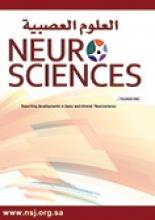Research ArticleOriginal Article
Open Access
Assessment of atherosclerotic risk among patients with epilepsy on valproic acid, lamotrigine, and carbamazepine treatment
Nudrat A. Zuberi, Mukhtiar Baig, Shazia Bano, Zehra Batool, Saeeda Haider and Tahira Perveen
Neurosciences Journal April 2017, 22 (2) 114-118; DOI: https://doi.org/10.17712/nsj.2017.2.20160342
Nudrat A. Zuberi
From the Department of Biochemistry (Zuberi), Unaizah College of Medicine, Qassim, the Department of Clinical Biochemistry (Baig), Faculty of Medicine, King Abdulaziz University, Jeddah, Kingdom of Saudi Arabia, the Department of Biochemistry (Bano), Jinnah Postgraduate Medical Center, the Department of Biochemistry (Batool), Jinnah University for Women, and the Neurochemistry and Biochemical Neuropharmacology Research Unit (Haider, Perveen), Department of Biochemistry, University of Karachi, Karachi, Pakistan
Msc, PhDMukhtiar Baig
From the Department of Biochemistry (Zuberi), Unaizah College of Medicine, Qassim, the Department of Clinical Biochemistry (Baig), Faculty of Medicine, King Abdulaziz University, Jeddah, Kingdom of Saudi Arabia, the Department of Biochemistry (Bano), Jinnah Postgraduate Medical Center, the Department of Biochemistry (Batool), Jinnah University for Women, and the Neurochemistry and Biochemical Neuropharmacology Research Unit (Haider, Perveen), Department of Biochemistry, University of Karachi, Karachi, Pakistan
MBBS, PhDShazia Bano
From the Department of Biochemistry (Zuberi), Unaizah College of Medicine, Qassim, the Department of Clinical Biochemistry (Baig), Faculty of Medicine, King Abdulaziz University, Jeddah, Kingdom of Saudi Arabia, the Department of Biochemistry (Bano), Jinnah Postgraduate Medical Center, the Department of Biochemistry (Batool), Jinnah University for Women, and the Neurochemistry and Biochemical Neuropharmacology Research Unit (Haider, Perveen), Department of Biochemistry, University of Karachi, Karachi, Pakistan
MBBS, MPhilZehra Batool
From the Department of Biochemistry (Zuberi), Unaizah College of Medicine, Qassim, the Department of Clinical Biochemistry (Baig), Faculty of Medicine, King Abdulaziz University, Jeddah, Kingdom of Saudi Arabia, the Department of Biochemistry (Bano), Jinnah Postgraduate Medical Center, the Department of Biochemistry (Batool), Jinnah University for Women, and the Neurochemistry and Biochemical Neuropharmacology Research Unit (Haider, Perveen), Department of Biochemistry, University of Karachi, Karachi, Pakistan
MscSaeeda Haider
From the Department of Biochemistry (Zuberi), Unaizah College of Medicine, Qassim, the Department of Clinical Biochemistry (Baig), Faculty of Medicine, King Abdulaziz University, Jeddah, Kingdom of Saudi Arabia, the Department of Biochemistry (Bano), Jinnah Postgraduate Medical Center, the Department of Biochemistry (Batool), Jinnah University for Women, and the Neurochemistry and Biochemical Neuropharmacology Research Unit (Haider, Perveen), Department of Biochemistry, University of Karachi, Karachi, Pakistan
Msc, PhDTahira Perveen
From the Department of Biochemistry (Zuberi), Unaizah College of Medicine, Qassim, the Department of Clinical Biochemistry (Baig), Faculty of Medicine, King Abdulaziz University, Jeddah, Kingdom of Saudi Arabia, the Department of Biochemistry (Bano), Jinnah Postgraduate Medical Center, the Department of Biochemistry (Batool), Jinnah University for Women, and the Neurochemistry and Biochemical Neuropharmacology Research Unit (Haider, Perveen), Department of Biochemistry, University of Karachi, Karachi, Pakistan
Msc, PhD
References
- ↵
- World Health Organization. Epilepsy factsheet No. 999
- ↵
- Khatri IA,
- Iannaccone ST,
- Ilyas MS,
- Abdullah M,
- Saleem S
- ↵
- Kullo IJ,
- Ballantyne CM
- ↵
- Tan TY,
- Lu CH,
- Chuang HY,
- Lin TK,
- Liou CW,
- Chang WN,
- et al.
- ↵
- Lopinto-Khoury C,
- Mintzer S
- ↵
- Mehrpour M,
- Zamani B,
- Abbasi M,
- Shojaie M,
- Gharibzadeh S
- ↵
- Chaung YC,
- Chaung HY,
- Lin TK,
- Chang CC,
- Lu CH,
- Chang WN,
- et al.
- ↵
- Nikolaos T,
- Stylianos G,
- Chryssoula N,
- Irini P,
- Christos M,
- Dimitrios T,
- et al.
- ↵
- Abaci A,
- Saygi M,
- Yis U,
- Demir K,
- Dirik E,
- Bober E
- ↵
- Grosso S,
- Mostardini R,
- Piccini B,
- Balestri P
- ↵
- Ben-Menachem E
- ↵
- Gaspari CN,
- Guerreiro CA
- ↵
- Pickrell WO,
- Lacey AS,
- Thomas RH,
- Smith PE,
- Rees MI
- ↵
- Hogan RE,
- Bertrand ME,
- Deaton RL,
- Sommerville KW
- ↵
- Devinsky O,
- Vuong A,
- Hammer A,
- Barrett PS
- ↵
- Sonmez FM,
- Demir E,
- Orem A,
- Yildirmis S,
- Orhan F,
- Aslan A,
- et al.
- ↵
- Tomoum HY,
- Awadallah MM,
- Fouad DA,
- Ali AH
- ↵
- Stocker R,
- Keaney JF Jr.
- ↵
- Mintzer S,
- Mattson RT
- ↵
- Svalheim S,
- Luef G,
- Rauchenzauner M,
- Morkrid L,
- Gjerstad L,
- et al.
- ↵
- Pachachi OA,
- Thanoon IA
- ↵
- Kim JY,
- Lee HW
- ↵
- Demircioglu S,
- Soylu A,
- Dirik E
- ↵
- Verrotti A,
- Manco R,
- Agostinelli S,
- Coppola G,
- Chiarelli F
- ↵
- Arida RM,
- de Almeida ACG,
- Cavalheiro EA,
- Scorza FA
- ↵
- Khot SS,
- Shaikh H,
- Lalitkumar G
In this issue
Assessment of atherosclerotic risk among patients with epilepsy on valproic acid, lamotrigine, and carbamazepine treatment
Nudrat A. Zuberi, Mukhtiar Baig, Shazia Bano, Zehra Batool, Saeeda Haider, Tahira Perveen
Neurosciences Journal Apr 2017, 22 (2) 114-118; DOI: 10.17712/nsj.2017.2.20160342
Jump to section
Related Articles
- No related articles found.
Cited By...
- No citing articles found.





